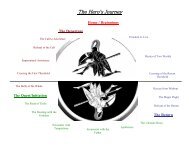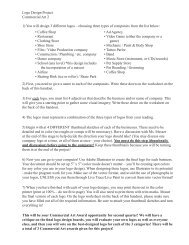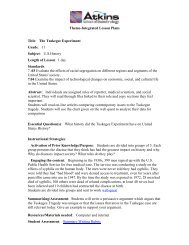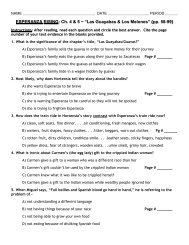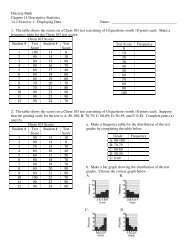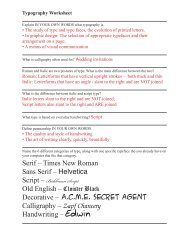The war dramatically expanded government powers, created new government ministries and powers, new taxes, and new laws wereenacted. As the war dragged on, conditions worsened throughout Europe, with more government centralization (control), economicregimentation, and manipulation of public opinion (propaganda). <strong>War</strong>time governments expanded their economies. Free marketcapitalism was put aside as the government stepped in to control price, wage, rent, rationing of food supplies and materials, regulationof imports/exports, and the nationalization of transport systems and industries. In total war, it became hard to tell the differencebetween life for a soldier and a civilian.As the war dragged on and conditions worsened, patriotic enthusiasm was replaced with dissatisfaction. Civilian morale was beginningto crack under the pressure of total war. As the powers of the government expanded, the police also gained more power to stifleinternal dissent. Britain passed the Defense of the Realm Act (DORA) which allowed dissenters to be arrested as traitors. DORAcensored newspapers, deleted objectionable material, and suspend the newspaper publication.France originally allowed public opposition to the war but by 1917 also cracked down, as the dissent weakened the French will to fight.Georges Clemenceau (1941-1929) became Prime Minister near the end of 1917 and cracked down. Basic civil liberties weresuppressed for the rest of the war. Asking for peace could get you imprisoned for 2 years as treason.The <strong>War</strong> Ends!Bulgaria was the first of the Central Powers to surrender. They signed an armistice Sept. 29, 1918.The Allied forces refused to negotiate with the German Kaiser and insisted on dealing with representatives of the German peopleinstead. Sept. 29, 1918 Germany’s top two generals Paul von Hindenburg and Erich Ludendorff pressured Kaiser Wilhelm II toestablish a constitutional monarchy. The Kaiser went into hiding in a Belgian resort but would not officially step down.His cousin Prince Max von Baden was named Chancellor and assumed leadership of the country. Max replaced the authoritariansystem of Bismarck with a parliamentary system. Prince Max immediately began to ask the Allies about an armistice--but he was notready to surrender unconditionally. He believed that he could negotiate favorable terms for Germany even though they had sufferedcontinuous losses on the battlefield. Germany had surrendered but had not been defeated. Germany was winning in much of Franceand Belgium when peace was established, and Germany won against Russia. Germany expected the terms of peace to be acceptableto everyone and to follow Wilson’s 14 Points.Wilson stated he would not begin to discuss an armistice until all German and Austrian soldiers left France, Belgium, and Serbia. TheGerman government agreed and withdrew its forces from France and Belgium, yet fighting on the Western front continued untilGermany announced it would cease all submarine warfare.Nov. 1918, the situation in Germany deteriorated from unstable to chaotic. German military leaders realized their attempt to breakthrough the Western front and capture Paris would not succeed. Germany was exhausted. Hunger, economic shortages, andfrustration at the policies of the German Kaiser led to riots in the streets and mutinies in the military-- especially in the Navy. Germanybroke out in revolution from Nov. 1918-August 1919.Meanwhile, Prince Max was ineffective in negotiating favorable terms. Wilhelm (still in hiding) would notofficially abdicate the throne so Max went public and announced the Kaiser was abdicating the throne. ThenPrince Max resigned.Germany had a Bolshevik party (like Russia) and a left-wing political group--the Social Democratic Party ofGermany (SPD) but neither one of these groups could get along. All of this disagreement weakened the leftwing socialist-communists parties so a democratic government took power—the Weimar Republic (Nov. 1918).This government was a republic (like America) with a new constitution and parliament (like our Congress).28
A group of Weimar German delegates (including Ferdinand Foch) arrived in France by train and were brought to a secluded location inthe woods of Compiegne, France. The delegates met in an old railway car to negotiate an armistice (which will be important again in<strong>World</strong> <strong>War</strong> Two). Hostilities officially ended at 11 am on November 11 th (the 11th hour of the 11th day of the 11th month) of 1918.It took seven more months before the formal peace treaties and all the arrangements were finalized. During that time, Germany wassurrounded by a naval blockade. Germany had to withdraw all troops from all borders, all sides had to preserve infrastructure,prisoners were exchanged, and the issue of war reparations had to be decided. All the Allied powers agreed that Germany must not beable to make war again.POWs: Let My People GoThe most dangerous moment in a war, is often the surrender, when helpless soldiers are sometimes gunneddown as they give up. Germans had 260,000 men wounded, missing, or dead. The British Empire had 300,000 (36,500 Australians, 3600 New Zealand, 16,000 Canadians, 90,000British subjects never identified, 42,000 never recovered). 1.4 million Allies were taken as prisoners of war (POWs). Austria 32%, Italy 26%, France 12%, Germany 9%, Britain 7% Russia had 2.5 - 3.5 million taken as prisoners of war. Central Powers had 3.3 million taken as POWs. Germany held 2.5 million prisoners. Russia held 2.9 million. Great Britain and France held 720,000. America held 48,000. The Ottoman Empire treated the POWs the worst. 12,000 Indian sepoys representing Great Britain were held after the Siegeof Kut (April 1916). 4000 died in captivity from starvation. “We were driven along like beasts to drop out and to die.”Results of the <strong>War</strong> 9 million soldiers, 10 million civilians died. 7 million soldiers were permanently disabled. Europe was no longer the center of the world. It was a scarred battleground. Physicaldevastation in Italy, Germany, Austria, Belgium, France, Russia, and Serbia.o France: vineyards and wheat fields were destroyed, trenches scarred the land,stray landmines and grenades.o Europe: piles of rubble that used to be churches, schools, hospitals ruined, famous art, libraries, and museumsdestroyed, piles of dead, wounded, mass graves Economic collapse in Europe. Europe had not planned for a long war. No one had the finances for a long, 4 year stalemate.The war costs totaled: $337 billion (more than 4.5 trillion today). Economic conditions were horrible. The major world powerswere financially devastated and faced bankruptcy. The nations were financially exhausted and produced more paper money topay back the war debt which caused inflation. Monarchies collapsed: Germany, Ottoman, Austria-Hungary, and Russia (Hohenzollern, Habsburg, Romanov, Ottoman). Thisalso created a power vacuum in the Middle East. Influenced the outbreak of WW2: dissatisfaction of Germany, Italy, Russia, Japan New countries established: Yugoslavia, Czechoslovakia, Poland, Finland, Estonia, Latvia, Lithuania (Oct 14, 1918). Austria, Hungary (divorced) became separate countries (Oct 25, 1918). America was now a global economic power—and the center of international finance.America invested in European loans ($3.7 billion invested in Europe).29




